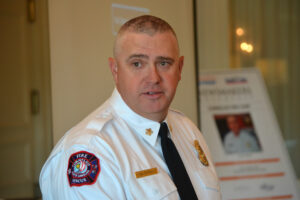NEWSMAKERS BREAKFAST | By Erica Batten
“Not many fire departments have the biggest lake in North Carolina in their back yard,” said Cornelius Fire Chief Guerry Barbee at the June Newsmakers Breakfast hosted by Cornelius Today. Lake Norman safety is just one of the unique challenges Barbee faces as he leads the fire department’s transition from an all-volunteer to a full-time paid force.
Barbee called the Cornelius Fire Department, which currently has just two stations, an “all-hazards, catch-all department.” Its mix of volunteers and professionals respond not only to lake emergencies, but also to incidents involving utilities, traffic accidents and other medical emergencies. And, of course, fires.
Fire emergencies in Cornelius can present challenges that other districts may not face. Not only are lakefront homes harder to access, they are also large compared to homes in denser residential areas. A homeowner could have a fire in the basement of a four-story home and not even realize it, said Barbee.
Commuter and industrial traffic on I-77 adds another layer to the unique mix of challenges.
“It’s become very taxing on the rescue service,” Barbee said, particularly over the past 25 years as the Cornelius population has ballooned to more than 30,000.
Contrast that with Sherrills Ford, another town on Lake Norman with a population less than one-fifth the size, where there are four fire stations.
Transition to full-time
Barbee said political support is needed for new facilities and for the robust transition to a full professional staff, a process that began in 2021 when the first full-time personnel joined the staff and will continue through 2036, by which time all firefighters will be full-time.

Cornelius Fire Chief Guerry Barbee | Photos by Jason Benavides
The change will require an annual budget of more than $3 million, Barbee said.
But the transition is necessary. A recent assessment conducted by the Center for Public Safety Management showed the volunteer model isn’t sustainable for Cornelius.
In addition to complex rescue demands and a mushrooming population, the recruiting and training environment has changed since Barbee joined the department 30 years ago.
He was a junior volunteer at age 16, following in the footsteps of his father and grandfather. By 18, he was training inside a controlled burn structure.
“Now you can’t do that. Now you must have certification,” Barbee said. “There are barriers that prevent new firefighters from doing what I did at 18.”
Fewer volunteers
Volunteerism is down across most organizations, but the rigorous and time-consuming training required is a bar to entry that many younger people won’t face without financial compensation. Even paid positions are challenging to fill.
“We try to help them understand that we have a wonderful benefits package,” Barbee said. “However, to a 20-year-old, he doesn’t care about the 401k, the insurance.”
The department has managed to attract 36 applicants as of last month. There are currently around 80 full-time and volunteer firefighters, and the plan is to add three full-time positions each year for at least the next decade.
While Barbee might like to see the transition happen a bit faster, the gradual approach will have a better outcome, he believes.
“We have guys that have 10, 15, 20 years-plus [experience]. We have guys that can instruct classes all across the nation,” he said.
“To have those young guys to come in, to have them work and learn under them is huge. I would not want to lose that at all.”
The gradual process will also mean that at least some of the new recruits will be able to train at a new facility. Central Piedmont Community College is planning a new first responder training facility on its Levine Campus in Matthews. The 23-acre property was donated by local business leader Rick Hendrick in June.













